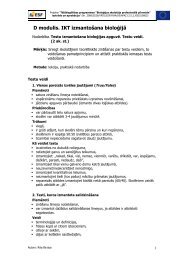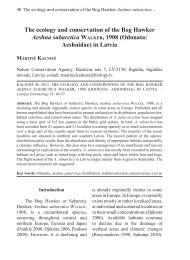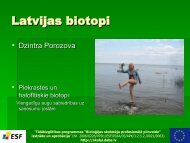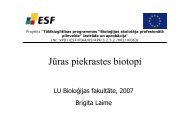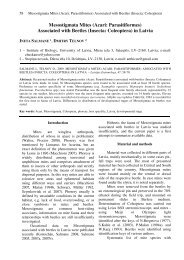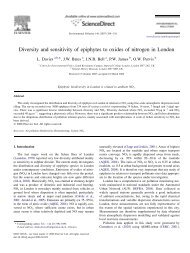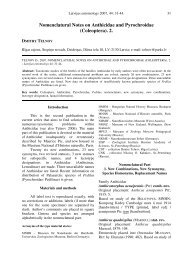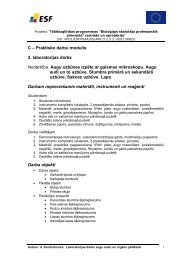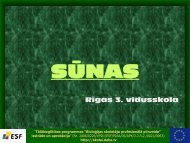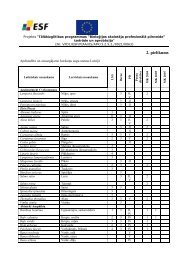Dissolved organic matter in water of Daugava river
Dissolved organic matter in water of Daugava river
Dissolved organic matter in water of Daugava river
You also want an ePaper? Increase the reach of your titles
YUMPU automatically turns print PDFs into web optimized ePapers that Google loves.
Application <strong>of</strong> Fluorescent Technologies to Identify Viable Pathogens <strong>in</strong>Dr<strong>in</strong>k<strong>in</strong>g WaterM.L<strong>in</strong>da 1 , T.Juhna* 11 Department <strong>of</strong> Water Eng<strong>in</strong>eer<strong>in</strong>g and Technology, Riga Technical University, Riga, Latvia.e-mail: L<strong>in</strong>da.mezule@rtu.lvWhen subjected to unfavourable environmental conditions or nutrient limitation manymicroorganisms (<strong>in</strong>clud<strong>in</strong>g pathogenic ones) can atta<strong>in</strong> a state <strong>of</strong> non-cultivability (viablebut not cultivable, VBNC) where they are unable to form visible colonies on traditionalculture media 1 . In environmental studies Fluorescent <strong>in</strong> situ hybridization (FISH) withfluorescent oligonucleotide or peptide nucleic acid probes have become an important tool<strong>in</strong> monitor<strong>in</strong>g and identification <strong>of</strong> certa<strong>in</strong> bacterial species or groups. However, studieshave shown that FISH alone is not a direct marker <strong>of</strong> cell viability. To monitor cellmembrane <strong>in</strong>tegrity, metabolic activity, enzymatic activity or ability to divide as such,different molecular assays have been developed. Our studies have shown that many <strong>of</strong>these assays can be comb<strong>in</strong>ed with specific identification <strong>of</strong> viable target species e.g. ableto divide Escherichia coli, <strong>in</strong> their natural environments, e.g. bi<strong>of</strong>ilm <strong>of</strong> dr<strong>in</strong>k<strong>in</strong>g <strong>water</strong>distribution system. Dur<strong>in</strong>g the years analyses on occurrence <strong>of</strong> Legionella species <strong>in</strong> hot<strong>water</strong> systems and enumeration <strong>of</strong> pathogenic protozoa <strong>in</strong> distribution systems have beenperformed with fluorescence microscopy. However, most studies have been performed onthe assessment <strong>of</strong> faecal <strong>in</strong>dicator E. coli <strong>in</strong> dr<strong>in</strong>k<strong>in</strong>g <strong>water</strong> distribution systems whichmeet current microbiological standards and potential <strong>in</strong>activation techniques for theseorganisms.The results have shown that <strong>in</strong> low numbers able to divide E. coli can be detected even <strong>in</strong>the bi<strong>of</strong>ilm <strong>of</strong> freshly treated <strong>water</strong>. On average around 53 % <strong>of</strong> all detected E. coli hadthe ability to divide and the concentration <strong>in</strong>creased with <strong>water</strong> residence time <strong>in</strong> thenetwork. At the same time no colonies were isolated on culture media. Monitor<strong>in</strong>g <strong>of</strong> E.coli concentration dynamics <strong>in</strong> dr<strong>in</strong>k<strong>in</strong>g <strong>water</strong> distribution system and pilot scale reactorsshowed that after the application <strong>of</strong> dis<strong>in</strong>fectant (chemical or mechanical) cells first losttheir cultivability (formation <strong>of</strong> colonies), then ability to divide (limited amount <strong>of</strong> time)and only then the metabolic activity (respiratory activity), <strong>in</strong>dicat<strong>in</strong>g on possibleunderestimation <strong>of</strong> pathogen concentration when traditional techniques have been used,thus, pos<strong>in</strong>g the risk for the consumer.1. Oliver JD. Recent f<strong>in</strong>d<strong>in</strong>gs on the viable but nonculturable state <strong>in</strong> pathogenic bacteria. FEMSMicrobiol Rev. 2010, vol. 34, p. 415–425.- 28 -



